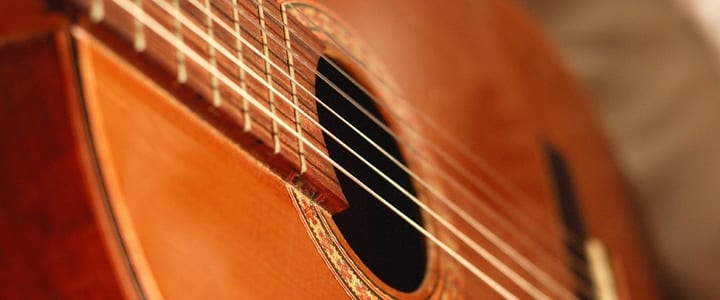In a previous post, Guitar Basics: Why is Technique Important?, guitar teacher Blake C. discussed the importance of utilizing proper technique, along with examples and ways to check your guitar playing technique. Here in Part Two, he continues with a helpful guitar exercise to try…
If you want to improve your technique, there are a few guitar exercises you can try. I call the first exercise “1-2-4 Exercise” merely because of the fingers used. This exercise is designed to improve multiple aspects of guitar playing technique for beginners or even more advanced guitar players. The first improvement aspect is fret-board balance, which is practiced as you focus your attention on utilizing proper finger position – pressing each note with the fingertips of the left hand (for right-handed guitarists or pressing with the right hand for left-handed guitarists) while not collapsing the joints of the fingers. Refer back to the pictures in this post to see the difference.
It is critical for guitarists to develop dexterity and nimbleness in order to attain a higher level of mastery of guitar playing. The “1-2-4 Exercise” addresses these skills as you increase the rate that the exercise is performed, while maintaining proper technique.
That in mind, begin this guitar exercise at a relatively slow tempo – for example, the 50 bpm setting on your metronome – allowing you to center your attention on proper technique. Keep in mind, if you simply play this exercise without concentrating on proper guitar technique, your efforts will not accomplish nearly as much in the long run.
Below are the notes and tab for the exercise. Although I began on the “A” note located at the 5th fret on the 6th string, the 1-2-4 pattern is obviously a moveable pattern. Beginning the exercise at the 5th fret is a better starting point than the first few frets because of the additional space your fingers must reach, as well as the additional distance your arm must reach. Conversely, beginning beyond the 12th fret creates a different dilemma as you begin the exercise – your fingers are crammed together!
So let’s begin the exercise at the 5th fret as shown here:
Remember, pick each note at a relatively slow rate when you first begin practicing. Focus your attention on pressing with your fingertips and not collapsing any joints of your fingers. As you practice this exercise, play one note for every metronome click.
After you are confident in your ability to play the notes fluidly without a pause when you change from one string to the next, increase the tempo in increments of 10 bpm on your metronome. With time and diligent practice, you will be able to play the exercise at a tempo exceeding 320 bpm.
After you successfully accomplish the exercise at the 5th fret, practice at other locations on the fretboard. In addition to improving your fretboard balance, dexterity, and overall nimbleness, this is one of the guitar exercises that is an excellent lead into soloing.
 Blake C. teaches songwriting, singing, and guitar lessons in Lowell, IN. He specializes in classical guitar technique as well as modern rock and blues styles. Blake has been teaching for 20 years and he joined the TakeLessons team in July 2013. Learn more about Blake here!
Blake C. teaches songwriting, singing, and guitar lessons in Lowell, IN. He specializes in classical guitar technique as well as modern rock and blues styles. Blake has been teaching for 20 years and he joined the TakeLessons team in July 2013. Learn more about Blake here!
Photo by Juan Barahona
Suzy S.


